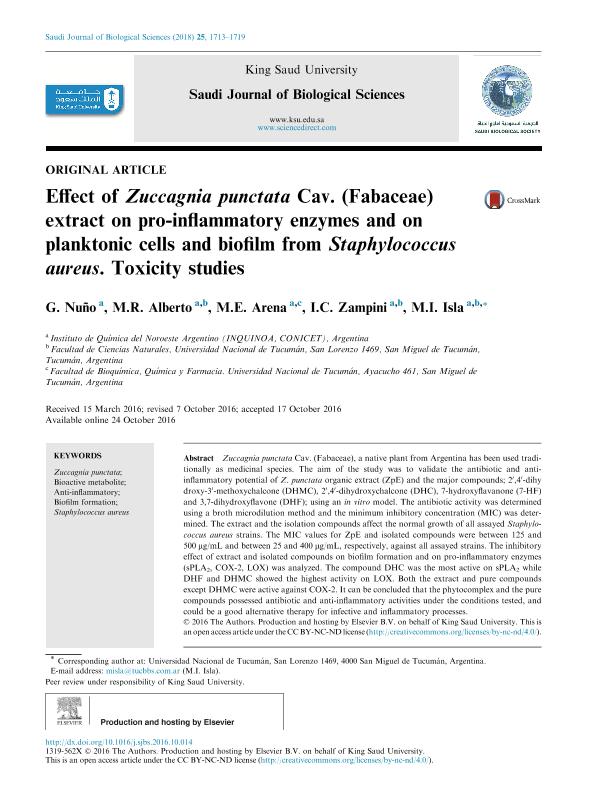Artículo
Effect of Zuccagnia punctata Cav. (Fabaceae) extract on pro-inflammatory enzymes and on planktonic cells and biofilm from Staphylococcus aureus: Toxicity studies
Nuño, Gabriela ; Alberto, Maria Rosa
; Alberto, Maria Rosa ; Arena, Mario Eduardo
; Arena, Mario Eduardo ; Zampini, Iris Catiana
; Zampini, Iris Catiana ; Isla, Maria Ines
; Isla, Maria Ines
 ; Alberto, Maria Rosa
; Alberto, Maria Rosa ; Arena, Mario Eduardo
; Arena, Mario Eduardo ; Zampini, Iris Catiana
; Zampini, Iris Catiana ; Isla, Maria Ines
; Isla, Maria Ines
Fecha de publicación:
10/2016
Editorial:
Elsevier
Revista:
Saudi Journal of Biological Sciences
ISSN:
1319-562X
Idioma:
Inglés
Tipo de recurso:
Artículo publicado
Clasificación temática:
Resumen
Zuccagnia punctata Cav. (Fabaceae), a native plant from Argentina has been used traditionally as medicinal species. The aim of the study was to validate the antibiotic and anti-inflammatory potential of Z. punctata organic extract (ZpE) and the major compounds; 2´,4´-dihydroxy-3´-methoxychalcone (DHMC), 2´,4´-dihydroxychalcone (DHC), 7-hydroxyflavanone (7-HF) and 3,7-dihydroxyflavone (DHF); using an in vitro model. The antibiotic activity was determined using a broth microdilution method and the minimum inhibitory concentration (MIC) was determined. The extract and the isolation compounds affect the normal growth of all assayed Staphylococcus aureus strains. The MIC values for ZpE and isolated compounds were between 125 and 500μg/mL and between 25 and 400μg/mL, respectively, against all assayed strains. The inhibitory effect of extract and isolated compounds on biofilm formation and on pro-inflammatory enzymes (sPLA2, COX-2, LOX) was analyzed. The compound DHC was the most active on sPLA2 while DHF and DHMC showed the highest activity on LOX. Both the extract and pure compounds except DHMC were active against COX-2. It can be concluded that the phytocomplex and the pure compounds possessed antibiotic and anti-inflammatory activities under the conditions tested, and could be a good alternative therapy for infective and inflammatory processes.
Archivos asociados
Licencia
Identificadores
Colecciones
Articulos(INQUINOA)
Articulos de INST.DE QUIMICA DEL NOROESTE
Articulos de INST.DE QUIMICA DEL NOROESTE
Citación
Nuño, Gabriela; Alberto, Maria Rosa; Arena, Mario Eduardo; Zampini, Iris Catiana; Isla, Maria Ines; Effect of Zuccagnia punctata Cav. (Fabaceae) extract on pro-inflammatory enzymes and on planktonic cells and biofilm from Staphylococcus aureus: Toxicity studies; Elsevier; Saudi Journal of Biological Sciences; 10-2016
Compartir
Altmétricas



